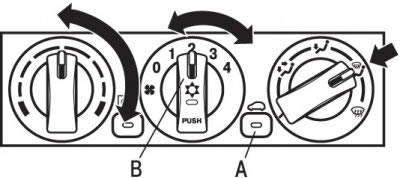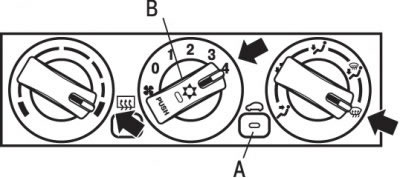
Pic. 1.43. Heater/air conditioner controls: 1 - air conditioner switch; 2 – switch of fan operation modes; 3 – ventilation mode selection knob; 4 – ventilation mode selection switch; 5 - air temperature adjustment knob
The air conditioner and heater can only operate when the engine is running. The performance of the heater is directly related to the temperature of the engine coolant, so turn on the heater after the engine has warmed up well. The airflow is adjusted using the fan speed control knob 2 (pic. 1.43).
Air conditioner switch
With the fan on, press the switch - conditioned air will begin to flow into the passenger compartment (in cooling/dry mode), and the air conditioning indicator light will come on. Pressing the switch again will turn off the air conditioner.
Note. Initially, fog may come out of the deflectors of the ventilation system. This is the result of a sharp cooling of moist air.
Attention! When the air conditioner is running, the idle speed increases slightly. If you have stopped the vehicle, fully depress the brake pedal to prevent it from moving slowly. This precaution is especially important for vehicles with automatic transmission.
Fan mode switch
You can select one of four fan speeds to adjust the airflow. The fan operation mode is set by turning the switch clockwise or in the opposite direction. Under normal conditions, you should set the first or second speed.
Air temperature adjustment knob
The heater is switched off if the handle is turned all the way to the left. Turn the knob to the right to increase the air temperature.
Note. If the engine coolant temperature is low, the temperature of the air supplied to the passenger compartment will not rise even if the air temperature control knob is turned to the high temperature side.
Ventilation mode selection
Deflectors / nozzles of the ventilation system, from which air is supplied, depending on the choice of ventilation modes, are given in Table. 1.1.
Designations:
- A - from the deflectors for blowing the windshield and side windows;
- IN - from the central and side deflectors;
- WITH - from under the instrument panel;
- D - from under the front seats.
Main airflow directions (ventilation modes):
Table 1.1 Deflectors / nozzles of the ventilation system, from which air is supplied, depending on the choice of ventilation modes

* Indicates weak airflow.
Note. Air is always supplied from the center and side vents, regardless of the position of the ventilation mode selection knob.
Air ventilation mode selection switch
Each time this switch is pressed, the ventilation modes change between fresh air intake and recirculation mode. In recirculation mode, the indicator lamp lights up.
Note. The outside air intake mode is usually used to quickly remove moisture or ice from the windshield and side windows and keep them clean.
The recirculation mode should be selected when intensive cooling of the passenger compartment air is required, as well as if the outside air is very dusty or polluted.
In this case, you should periodically turn on the outside air intake mode to avoid fogging the windows.
Footwell heating
Install the ventilation mode selection knob and the air intake mode selection switch A to the positions shown in Fig. 1.44. Adjust the temperature by turning the temperature control knob clockwise or counterclockwise. Select the desired fan speed.

Pic. 1.44. Button Location (A) selection of the ventilation mode and the position of the handles in the heating mode of the footwell
Note. For maximum heating, set the fan mode switch to the third speed.
Combination of hot and cold air
Install the ventilation mode selection knob and the air intake mode selection switch A to the positions shown in Fig. 1.45. The air flow will be directed towards the feet and into the upper part of the cabin. Select the desired fan speed.
Warm air is supplied to the feet, and cold or slightly heated air is supplied to the upper part of the cabin.

Pic. 1.45. Button Location (A) selection of the ventilation mode and the position of the handles in the mode of supplying a combination of heated and cold air
Elimination of fogging of a windshield and glasses of doors
To remove frost or condensation (fogging) from the windshield or door windows, set the ventilation mode selection knob to

Pic. 1.46. Button layout (A) selecting the ventilation mode, turning on the air conditioner (IN) and the position of the handles in the defogging mode of the windshield and door glasses
1. Set the ventilation mode selection knob A (see fig. 1.46) to the outside air intake position.
2. Set the air intake mode selection switch to
3. Set the desired fan speed.
4. Adjust the temperature.
5. Press the air conditioner switch IN (for vehicles equipped with air conditioning).
Fast fogging removal (fast heating) glasses
For quick fog removal (rapid heating) glass do the following.
1. Set the ventilation mode selection knob A (pic. 1.47) to the outside air intake position.

Pic. 1.47. Button layout (A) selecting the ventilation mode, turning on the air conditioner (IN) and the position of the knobs in the quick demist mode (rapid heating) glasses
2. Set the air intake mode selection switch to
3. Adjust the fan speed by setting the maximum fan speed.
4. Adjust the temperature by turning the air temperature control knob to the maximum.
5. Press the A/C switch B (for vehicles equipped with air conditioning).
Note. To effectively defog the windows, direct the air flow from the side vents to the door windows and cover the center vents.
Note. Do not set the air temperature adjustment knob to a position close to the maximum cooling position. The cooled air will be supplied to the door glass and condense (fogging).
Supply of outside air to the cabin
To supply outside air to the passenger compartment in hot weather, set the air intake mode selection switch A to the outside air intake mode and the air temperature adjustment knob to the positions shown in Figure 1.48. Make sure the temperature control knob is set all the way to the left. Select the desired fan speed.

Pic. 1.48. Button Location (A) selection of the ventilation mode and the position of the handles in the mode of supplying outside air to the car interior
Turn the ventilation mode selector knob clockwise and the airflow will be directed towards the feet and windshield.
Cooling (for vehicles with air conditioning)
Set the ventilation mode selection knob to

Pic. 1.49. Button layout (A) selecting the ventilation mode, turning on the air conditioner (IN) and the position of the handles in cooling mode (for vehicles with air conditioning)
Adjust the temperature by turning the air temperature adjustment knob clockwise or counterclockwise.
Select the desired fan speed.
Note. If the outside air is dusty, too dirty, or the passenger compartment air needs to be quickly cooled, set the air intake mode selection switch to the recirculation position and turn the temperature control knob all the way to the left. Periodically switch to the outside air intake mode so that moisture does not condense on the windows.
